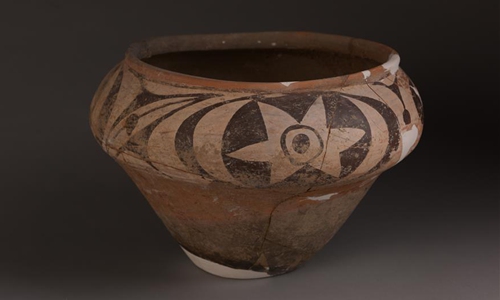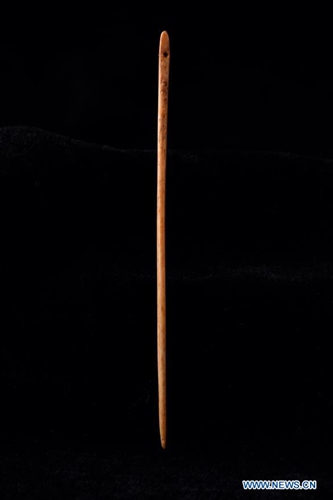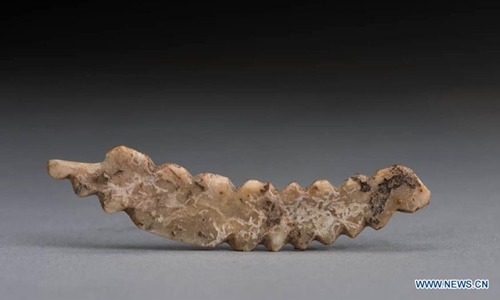Archaeological findings provide key proof of Chinese civilization origin
Source:Xinhua Published: 2020/5/7 18:14:25

Undated file photo provided by Zhengzhou Municipal Institute of Archaeology shows a painted pottery ware unearthed in the Shuanghuaishu Remain in Gongyi City, central China's Henan Province.Photo:Xinhua
Chinese archaeologists announced Thursday significant achievements at the Shuanghuaishu site in central China's Henan Province, providing key proof of the origin of the over 5,000-year-long Chinese civilization.
With an area of 1.17 million square meters, the Shuanghuaishu site is located on the south bank of the Yellow River in the township of Heluo, Gongyi City.
The ancient city relic dating back to around 5,300 years ago was proposed by Chinese archaeologists to be named "Heluo Kingdom" after its location in the center of Heluo area, where the Yellow River (known as He in ancient China) and the Luohe River meet.
"The Shuanghuaishu site is the highest-standard cluster with the nature of a capital city discovered so far in the Yellow River basin in the middle and late stage of Yangshao Culture, the early stage of the formation of Chinese civilization," said Li Boqian, a professor at Peking University, at a press conference on major archaeological discoveries at Shuanghuaishu site held Thursday in Zhengzhou, the provincial capital.
A large number of relics of the Yangshao Culture dating back 5,000 to 7,000 years have been discovered at the site, said Gu Wanfa, director of the Zhengzhou Municipal Research Institute of Cultural Relics and Archaeology, at the press conference.
"The important archaeological findings prove the representativeness and influence of the Heluo area in the golden stage of the origin of Chinese civilization around 5,300 years ago," said Wang Wei, a member of the Chinese Academy of Social Sciences.
Since 2013, the Zhengzhou Municipal Research Institute of Cultural Relics and Archaeology and the Institute of Archaeology of the Chinese Academy of Social Sciences have conducted continuous archaeological excavations on the site.

Undated file photo provided by Zhengzhou Municipal Institute of Archaeology shows a painted pottery ware unearthed in the Shuanghuaishu Remain in Gongyi City, central China's Henan Province.Photo:Xinhua
According to archaeologists, the Shuanghuaishu site was about 1,500 meters long from east to west and 780 meters wide from north to south. It was surrounded by three ring trenches with each found to have external access, forming a strict defense system.
The central residential area with four rows of houses was found in the northern part of the inner ring moat. Meanwhile, three public cemeteries with more than 1,700 tombs, three sacrificial remains, an astronomical relic, a pottery workshop area, a water storage area, a road system and other facilities were also discovered at the city ruins.
At the astronomical relic, nine pottery pots were arranged in the pattern of the nine stars of the Big Dipper. Experts said the relic indicates that the ancestors of Heluo had relative mature astronomical knowledge to guide agricultural activities by observing the celestial phenomena.
Among the unearthed relics, a boar tusk carving of a silkworm, 6.4 cm long, nearly 1 cm wide and 0.1 cm thick, was believed to be China's earliest carving depicting silkworms. Experts say that the carving depicts a spinning silkworm which is quite similar to modern silkworms in appearance.

Undated file photo provided by Zhengzhou Municipal Institute of Archaeology shows a painted pottery ware unearthed in the Shuanghuaishu Remain in Gongyi City, central China's Henan Province.Photo:Xinhua
Posted in: SOCIETY,CHINA FOCUS